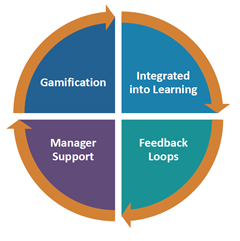ATD Blog
Micro-Coaching: Maximize Impact and Minimize Time
Fri Oct 16 2020

“As talent development professionals our ability to be treated as a strategic business partner lies in our ability to demonstrate improved performance and a positive return on investment.” —Michael Leimbach
With that underlying assumption, the recent ATD Forum ConnectSpark presented by Michael Leimbach, vice president of global research and development at Wilson Learning Worldwide, provides a deep dive into the biggest impact on learning transfer—namely, manager involvement in engaging and coaching employees.
Workplace Learning Realities
The current reality is that most organizations are not getting the impact from learning that they need. For example, studies show people may forget up to 70 to 80 percent of what they learned in traditional training workshops. This already dismal retention figure has not helped with the move to self-directed and virtual learning, and now even more so with the increase in remote learning due to COVID-19 restrictions.
So, how do we as talent development professionals increase our impact and improve learning outcomes? How do we make sure learning transfers to enhanced work performance? How do you make sure people are employing the skills they learn?
Key Research Findings
Michael Leimbach and team conducted a meta-analysis and literature review of where people implemented activities to try to impact learning on performance and looked at the relative improvement due to key factors.
Of the 11 factors that have a measurable impact on learning transfer, studies showed that the single-biggest impact on learning transfer to work performance was if a manager was involved in supporting and coaching the employee. However, research shows that manager coaching is at an all-time low, with Gallup reporting that 75 percent of employees say they do not receive meaningful coaching from their managers.
If the key to maximizing learning transfer is involving managers, what gets in the way of managers’ coaching? Surveys across industries show that managers report three key reasons:
Not having the time to coach
Not knowing how to coach
Not having learned the skills our staff are learning
Realizing these barriers, the Wilson Learning Worldwide team came up with a process to help managers address them. Their solution: micro-coaching.
How to Incorporate Micro-Coaching Into Learning Design
Micro-coaching is based on the idea of introducing small, incremental, work-related engagements with learners around focused, on-the-job scenarios. Michael specified there are four main elements to successful micro-coaching:

1. Need to integrate into learning. Coaching is ineffective when it is considered an add-on or afterthought to learning design. Coaching needs to be integrated into the flow of the learning and it needs to be linked to specific application of the skills being taught.
2. Provide feedback loops. Since one of the biggest barriers to manager coaching is the time (or perception of time it takes), there needs to be a feedback loop between the manager/coach and the employee/learner that is easy to implement and provides timely, meaningful feedback, insight, and support.
3. Manager support. Managers often need to be supported in their own learning, and that means they need information on the actual skill or capability their employee is being trained on. In some instances, this will play out in practice with managers attending the same training as their staff. Other times, organizations may turn to a learning platform that provides coaching tips for managers.
4. Gamification. The final piece is adding game-like components to increase interest and engagement in learning—for example, through progress indicators, completion rates, and leader boards.
Michael further illustrated this four-part process by sharing a case study of people engaged in sales training as employing a PPP framework—an application exercise involving the purpose, process, and payoff that can be used to drive micro-coaching sessions.
He also introduces the creative uses of videoing practice sessions—via webcam or smartphone—moving preparation and setting intention into real-world learning and application through behavior rehearsal. This is a gamechanger in that it allows the employee and the manager to review critical skills—in this case a specific sales approach—for mutual observation and interpretation. This micro-coaching by managers as a cultural competency ultimately enhances a team or organization’s ability to both witness and measure professional growth and learning impact.
In Summary
One of the most important takeaways is that a manager coaching adequately is far superior than an expert coaching perfectly. Micro-coaching in short—three-, five-, 10-minute—blocks of time with clear exercises to drive coaching sessions and timely feedback can maximize learning impacts.
Bottom line: If you develop capabilities to increase manager involvement in learning—by managers consistently coaching employees—it will create a practical “stickiness” to all learning. And as Michael reminded us, a guiding principle for our L&D profession going forward is that “It’s not important how much people learn, but how much they use.”
